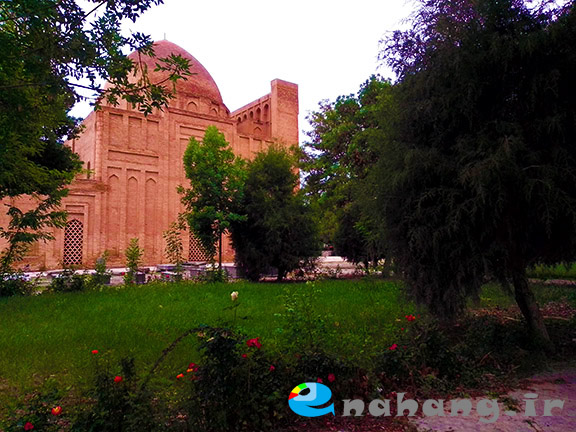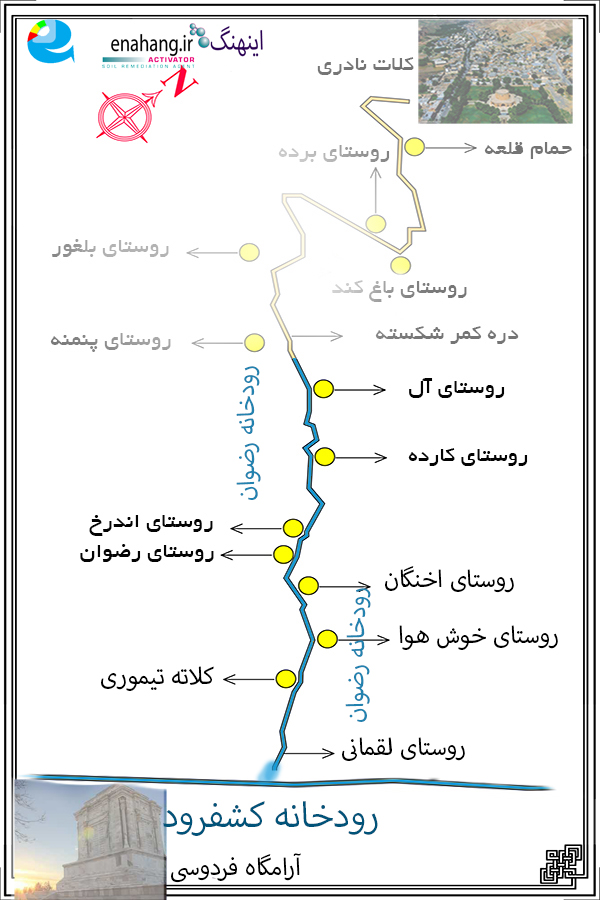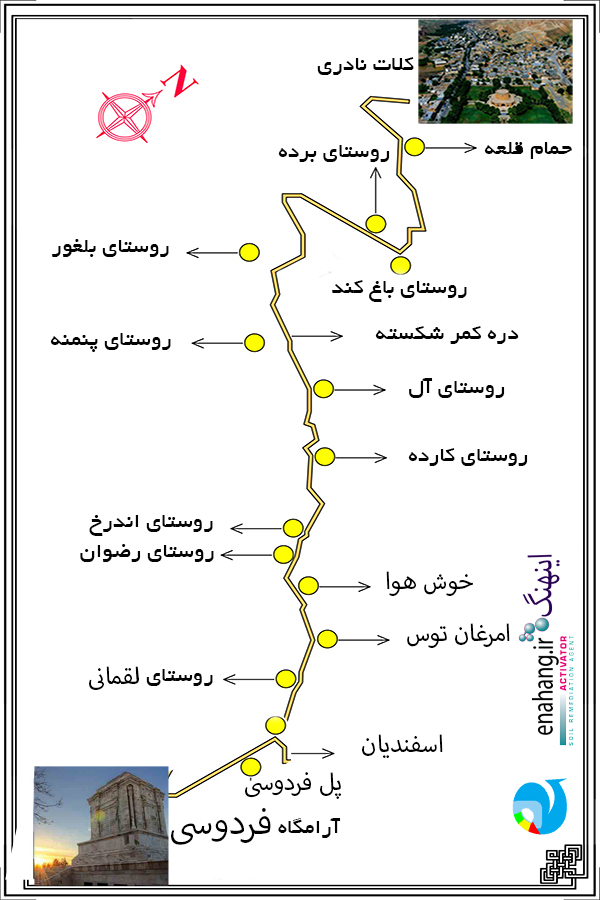
Kashafrud river - رودخانه کشف رود
اینجا درباره رودخانه کشفرود ایران مینویسم
Kashafrud river - رودخانه کشف رود
اینجا درباره رودخانه کشفرود ایران مینویسمسفر یکروزه به کلات
نیمه اردیبهشت 1404 هست. کاخ خورشید کلات رو مشهدی ها حداقل یک بار در عمر خود رفته اند. اینبار قصد دارم مسیر شهر توس به کلات را براتون بگم.
شهر توس پر هست از آثار باستانی و موزه. به جز آن، آرامگاه حکیم ادب و حماسه، ابولقاسم فردوسی رو هم دربرگرفته. بعد از این حکیم گرانقدر ستاره های ادب فارسی معاصری چون مهدی اخوان ثالث و محمدرضا شجریان نیز در آرامگاه فردوسی دفن هستند. آرامگاه فرودسی رو ایرانی ها حداقل یکبار در عمر خود رفته اند.
برای اتراق مردمی که به دیدن آرامگاه فردوسی می آیند، حدفاصل پل فردوسی و هارونیه تا آرامگاه یک پارک کالیگرافی گذاشته اند که در آرامش هم بتوان از مناظر و مجسمه های خان های نبرد رستم در شاهنامه عکس گرفت و هم بتوان لحظاتی خوش را داشت.

بقعه در تصویر بالا و مجسمه ها در تصویر پایین:
_cj0i.jpg)
معماری بقعه هارونیه هم جذابیت های خودش را داره:
_rur7.jpg)
در کنار بقعه مسجدی بوده که بقایای آن هست:
_c2no.jpg)
برای رفتن از محل آرامگاه فردوسی شهر توس، این طرف یال های رشته کوه هزار مسجد قرار گرفته به آن طرف یال های کوه ها که کلات قرار داره. قبل از رسیدن به چهاربرج از پل فردوسی که رودبار دروازه شهر باستانی توس هست رد میشویم تا به روستای لقمانی، محل اتصال دو رود رضوان و کشفرود برسیم:

برخی به رودخانه رضوان، رودخانه کارده نیز می گویند و این به دلیل سدی است که بر سر آن با نام کارده بسته اند.
جاده رضوان به کلات چندکیلومتری به شهر توس مانده شروع میشود, این جاده کلات هیچ شباهتی به یک جاده ترانزیت نداشته و بیشتر یک جاده فراموش شده و مخروبه است، هرچند خودروهای زیادی به دلیل آرامستان رضوان که تجمیع آرامستان های روستاهای اطرافه، از آن عبور می کنند. به دلیل هم مسیر بودن این جاده با رودخانه رضوان در طول مسیر گویی باید از میان چند "جویِ خالی از آب" رانندگی کنی و فرمان خودرو به جای اینکه دست راننده باشد در دستانِ پیر جاده قدیمی است, طوری که دیدن مناظر بسیار زیبایِ مسیر جاده رضوان به کلات ( آنهم درفصل بهار ) را لااقل برای راننده مشکل می کند , جاده ای که در کناره اش جایی برای توقف , نه که بگویم اصلاً ندارد، کم دارد.

بخشی از رشته کوه هزارمسجد در شهرستان کلات واقع شده است , اصلا همین جاده کلات از کوههای هزار مسجد میگذرد و کوه آل که سرچشمه سد کارده بر روی رودخانه رضوان است در مسیر آن قرار دارد.
با ادامه رشد شهرهایی مثل کلانشهر مشهد، بر میزان زمین های رطوبت ناپذیر افزوده شده. در نتیجه منابع آب زیرزمینی محدودتر شده اند. رسوخ مواد شیمیایی یا آبهای آلوده به آبهای جاری منطقه سبب آلودگی رودخانه ها و نیز نابودی آبزیان میشود. این خشکی و کم آبی زندگی ساکنین مناطق اطراف رودخانه های رضوان و کشفرود را تحت تاثیر قرار داده است. از میزان آبهای زیرزمینی کاسته شده و تبخیر آب از سطح زمین افزایش یافته است.
به دنبال کاهش دسترسی به منابع آبی زیرزمینی، باید بر عمق چاه های آب افزود و یا حداقل به خارج از محدوده شهرها روی آورد تا بتوان نیازهای شهرنشینان را برآورده ساخت. پیشرفت های جدید اصول اساسی تامین آب را تغییر نداده اند. اخیرا موارد بسیاری از آلودگی منابع آبی زیرزمینی و سطحی کشفرود گزارش شده است که شمار بزرگی از آن با روند شهرسازی و شهرنشینی در رابطه اند. مهم ترین این موارد عبارتند از:
حفر چاه به منظور انباشتن مواد آلوده ساز و زباله ها، رها کردن مواد یاد شده در خیابانها، مناطق صنعتی، راه های آهن و فرودگاه ها، نشت آبهای آلوده از لوله ها و مخازن فاضلاب، بی توجهی به چاه های آب، استفاده بی رویه از مواد شیمیایی ویژه امور کشاورزی، وجود حوضه های آب آلوده بدون سرپوش، و رسوخ آبهای شور به منابع آب زیرزمینی.
تامین آب از لایه های ژرف و ژرفتر نیز خود سبب فرونشستن زمین میگردد. کلانشهر مشهد و گسترش آن به شهر توس چنین مشکلاتی را دوچندان کرده است. در مناطقی از دشت مشهد که شامل شهرتوس نیز میشود سالانه بیست سانت فرونشست داریم که کسی متوجه آن نیست. اگر این روند ادامه بیابد تمامی یک ساختمان برج مرکز شهر مشهد در سطحی پایین تر از دریا قرار میگیرند، و دلیل این امر چیزی به جز تهی شدن منابع زیرزمینی از آب نیست.
_______________
One-day trip to Kalat
It is mid-May 2025. The Sun Palace of Kalat has been visited by Mashhadites at least once in their lives. This time I intend to tell you the route from Toos to Kalat.
Toos is full of ancient monuments and museums. In addition, it contains the tomb of the sage of literature and epic, Abolghasem Ferdowsi. After this great sage, stars of contemporary Persian literature such as Mehdi Akhavan Thaleth and Mohammad Reza Shajarian are also buried in Ferdowsi's tomb. Iranians have visited Ferdowsi's tomb at least once in their lives.
For the comfort of people who come to visit Ferdowsi's tomb, a calligraphy park has been set up between the Ferdowsi Bridge and Harounieh to the tomb, where you can take pictures of the scenery and statues of the khans of the Battle of Rostam in Shahnameh and have fun.
The tomb in the picture above and the statues in the picture below:
The architecture of the Harunieh tomb also has its own charms:
Next to the tomb was a mosque with its remains:
To go from the site of Ferdowsi's tomb in Toos, on this side are the ridges of the Hezar Masjid mountain range to the other side of the ridges of the mountains where Kalat is located. Before reaching Chahar Borj, we pass by Ferdowsi Bridge, which is the gateway to the ancient city of Toos, to reach the village of Logmani, the junction of the two rivers Rezvan and Kashfrud:
Some also call the Rezvan River the Kardeh River, and this is because of the dam that has been built across it with the name Kardeh.
The Rezvan-Kalat road begins a few kilometers from Toos. This Kalat road has nothing to do with a transit road and is mostly a forgotten and dilapidated road, although many cars pass through it because of the Rezvan Mausoleum, which is a collection of mausoleums from surrounding villages. Due to the fact that this road runs parallel to the Rezvan River, it seems as if you have to drive through several "waterless streams" along the way, and the steering wheel of the car is in the hands of the old road, instead of the driver's hands, so that it is difficult for the driver to see the very beautiful scenery of the Rezvan-Kalat road (especially in spring), a road that has no place to stop, not to say that it does not have any, it is lacking.
Part of the Hezar Masjid mountain range is located in Kalat city, and the Kalat road itself passes through the Hezar Masjid mountains, and Mount Al, which is the source of the Kardeh Dam on the Rezvan River, is located on its route.
With the continued growth of cities such as the Mashhad metropolis, the amount of impermeable land has increased. As a result, groundwater resources have become more limited. The infiltration of chemicals or contaminated water into the flowing waters of the region causes pollution of the rivers and also the destruction of aquatic life. This drought and water shortage have affected the lives of residents of the areas around the Rezvan and Kashfrud rivers. The amount of groundwater has decreased and evaporation from the ground surface has increased.
As access to groundwater resources has decreased, the depth of water wells must be increased or at least moved outside the city limits to meet the needs of urban dwellers. New developments have not changed the basic principles of water supply. Recently, many cases of contamination of groundwater and surface water resources have been reported, a large number of which are related to the process of urban development and urbanization. The most important of these cases are:
Drilling wells to accumulate pollutants and waste, dumping the aforementioned materials on streets, industrial areas, railways and airports, leaking contaminated water from pipes and sewage tanks, neglect of water wells, excessive use of chemicals for agricultural purposes, the existence of contaminated water basins without covers, and the infiltration of salt water into groundwater resources.
Water supply from deeper and deeper layers also causes land subsidence. The metropolis of Mashhad and its expansion to Toos city have compounded such problems. In areas of the Mashhad plain, which includes Toos city, we have a subsidence of twenty centimeters per year, which no one notices. If this trend continues, an entire tower building in the center of Mashhad city will be below sea level, and the reason for this is nothing other than the depletion of underground water resources.